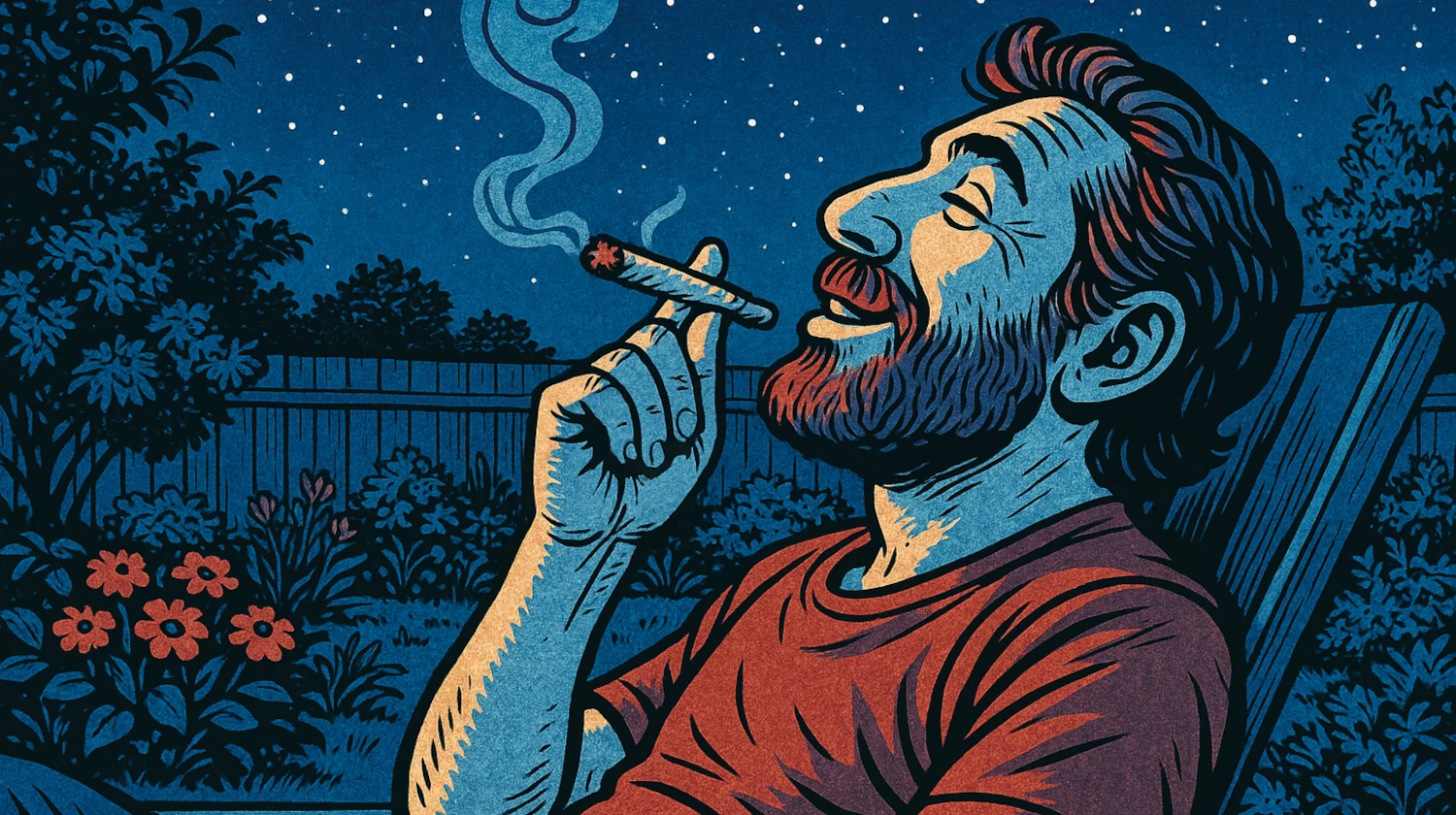Cannabis can produce a range of effects, often categorized as either a head high or a body high. A head high typically offers cerebral stimulation, enhancing creativity and mood. A body high may instead provide physical relaxation and a sense of calm.
What Does a Body High Feel Like?
As the name suggests, a body high usually provides users with pleasant physical sensations. Commonly reported outcomes include increased relaxation and a feeling of weightlessness, but more often, consumers experience a sedative couch-lock effect. While significant in the impact delivered, a body high tends to leave consumers feeling comfortable, with a warm and soothing effect often setting in.1
Many people turn to body highs to relieve physical and chronic pain. Each strain delivers a different effect, making it difficult to pinpoint the exact benefits of a body high. Cannabis users often seek out these types to treat issues such as:
- Muscle Relaxation: Many cannabis strains are reported to provide muscle relief for daily after-work pains and more persistent issues and conditions.
- Pain Relief: Beyond muscle pain, body-high strains have reportedly helped people find relief with more chronic conditions, such as arthritis and fibromyalgia.
- Calming Sensation: Body highs tend to put consumers in a sedative state, making many people feel calm after consuming.
- Improved Sleep: The combined effects of body-high strains are reported to put the consumer in a prime position to doze off or fall into a deep sleep.
Each strain and its plant compounds will help to varying degrees. A consumer's unique body composition and medical needs play an equal, if not greater, part in the outcome delivered.
Years of misinformation have led many to believe that "indica" labeled strains provide body highs, while "sativa" labeled strains provide head highs. There is some truth to this, as strains labeled "indica" tend to contain higher quantities of the terpene myrcene, usually associated with narcotic life sedative effects.2 However, assuming all indica-labeled strains have high levels of myrcene and deliver soothing body-high effects would be incorrect.3 Be sure to check out a strain's plant profile whenever possible to get the best idea of its expected effects.
What Does a Head High Feel Like?

A head high typically impacts our mind and emotions. Rather than providing physical relief, it is often associated with improved mental clarity, reduced anxiety, increased creative energy, heightened awareness, and other positive impacts on our mental state. The increased energy and elevated levels of euphoria often lead many to consider head highs more effective for daytime consumption and social situations. In some cases, the results have been characterized as spacey or hallucinogenic.
No matter the case, head highs are often associated with optimism and uplifted spirits. The sensations delivered by a head high leave many recreational and medical consumers to seek these out for various conditions and issues, such as:
- Elevated Mood: Head highs are reported to deliver uplifting effects that venture into euphoria.
- Enhanced Creativity: Uplifted moods and increased awareness are reported to help many find an increased creative output.
- Increased Energy: Head highs are often associated with raising a person's energy, leading many to consider it superior for the daytime.
- Elevated Awareness: Individuals have associated head highs with increased sensory effects, leading some consumers to experience a more acute perception of color, taste, and sound.
Each strain and its associated cannabinoids, terpenes, and other compounds will all play a part in the effects felt. While considering strain composition, be aware that body composition and the consumer's needs will also have an effect on the outcome.
Head highs are often associated with sativa-labeled strains and their uplifting, energetic cerebral effects. While sativa-labeled strains typically deliver elevated outcomes, consumers should not assume that all plants will do the same.
Whether checking out a strain labeled as sativa or an indica, be aware of the plant compounds and how they may affect you. Understanding the cannabinoid, terpene, and other plant compound analysis will give you a much better expectation of effects than an indica or sativa distinction will.
Head High vs Body High: What's the Cause?

Many today associate body and head high with either sativa or indica strains. But a strain's complete profile has much more effect than the indica or sativa label. When it comes to understanding the cause of these effects, consumers should focus on two critical plant components:
- Cannabinoid Content: Cannabis contains well over 120 various cannabinoids, with each playing a part in the effects delivered. THC and CBD are the most dominant and well-known cannabinoids, but they are joined by numerous others to determine the type of high felt by an individual.
- Terpene Content: Terpenes are compounds found throughout the plant but are primarily concentrated in the trichomes. These compounds play a critical role in the effects delivered, along with the taste and aroma of a strain. With more than 100 terpenes found in cannabis, the results can vary significantly from strain to strain.4
Strains higher in myrcene may produce a body high and sedative couch lock effects. Conversely, strains higher in limonene are often reported to produce increased energy and alertness.5 By combining a strain's complete plant profile, including primary and minor cannabinoids, terpenes, and other plant metabolites, many believe consumers can experience the best of the plant and its effects.6 This combined consumption of plant compounds has been coined as the entourage effect, but research has yet to determine many terpenes that may facilitate this effect and how.7
Strain labels like indica or sativa can offer general guidance. But the specific effects of a cannabis product are more accurately predicted by its cannabinoid and terpene profile. Considering these compounds can provide a more personalized and effective cannabis experience.
How to Choose Your Experience
Having a body or head high is your choice. The best way to know what to expect is to understand the whole plant profile. Whenever possible, learn about the strain's total makeup, including its cannabinoids, terpenes, and other plant metabolites. While THC percentage is a helpful factor, understanding the entire composition of the plant will give you a better idea of what to expect. It may help to familiarize yourself with some of the most common cannabis terpenes and what effects they are most associated with. They include:
The method of consumption won't impact if you have a body or head high. However, the process will determine how quickly you feel high, the length of the effects, and how substantial you may experience them. For example, those seeking an immediate effect may want to smoke some flower. Those looking for immediate results but more significant effects may wish to use a vape cartridge or do a dab. Edibles will take longer to kick in but may feel substantially more potent compared to smoking. Those looking for faster effects than an edible but don't want to smoke or vape may wish to consider a tincture that can be consumed sublingually.
Best Strains for a Body or Head High

For those seeking specific experiences, consumers often recommend certain cannabis strains to have either a head or a body high.
Some of the Best Strains for a Body High:
- Northern Lights
- OG Kush
- Blue Dream
- Velvet Kush
- Blackberry Kush
- Purple Kush
Some of the Best Strains for a Head High:
- Sour Diesel
- Green Crack
- Jack Herer
- SFV OG
- True OG
- Tahoe OG
- Fire OG
- Neptune OG
- Larry OG
- Heroijuana OG
- Platinum OG
- Skywalker OG
Both head highs and body highs can offer enjoyable effects. If you want to feel more uplifted or focused, a head high might be best. If you're looking for deep relaxation, a body high could be the way to go. And remember, you may not react to a strain the same way as another consumer. Try different strains and pay attention to how each one feels; it’s the best way to find what works for you.
References
- Hazekamp A, Fischedick JT. Cannabis - from cultivar to chemovar. Drug Test Anal. 2012;4(7-8):660-667. doi:10.1002/dta.407 ↩︎
- Lewis MA, Russo EB, Smith KM. Pharmacological Foundations of Cannabis Chemovars. Planta medica. 2017;84(04):225-233. doi:https://doi.org/10.1055/s-0043-122240 ↩︎
- Hazekamp A, Tejkalová K, Papadimitriou S. Cannabis: From Cultivar to Chemovar II—A Metabolomics Approach to Cannabis Classification. Cannabis and Cannabinoid Research. 2016;1(1):202-215. doi:https://doi.org/10.1089/can.2016.0017 ↩︎
- Radwan MM, Chandra S, Gul S, ElSohly MA. Cannabinoids, Phenolics, Terpenes and Alkaloids of Cannabis. Molecules. 2021; 26(9):2774. https://doi.org/10.3390/molecules26092774 ↩︎
- Piomelli D, Russo EB. The Cannabis sativa Versus Cannabis indica Debate: An Interview with Ethan Russo, MD. Cannabis Cannabinoid Res. 2016;1(1):44-46. Published 2016 Jan 1. doi:10.1089/can.2015.29003.ebr ↩︎
- Procaccia S, Lewitus GM, Lipson Feder C, Shapira A, Berman P, Meiri D. Cannabis for Medical Use: Versatile Plant Rather Than a Single Drug. Frontiers in Pharmacology. 2022;13. doi:https://doi.org/10.3389/fphar.2022.894960 ↩︎
- Booth JK, Bohlmann J. Terpenes in Cannabis sativa – From plant genome to humans. Plant science. 2019;284:67-72. doi:https://doi.org/10.1016/j.plantsci.2019.03.022 ↩︎
The information in this article and any included images or charts are for educational purposes only. This information is neither a substitute for, nor does it replace, professional legal advice or medical advice, diagnosis, or treatment. If you have any concerns or questions about laws, regulations, or your health, you should always consult with an attorney, physician or other licensed professional.




